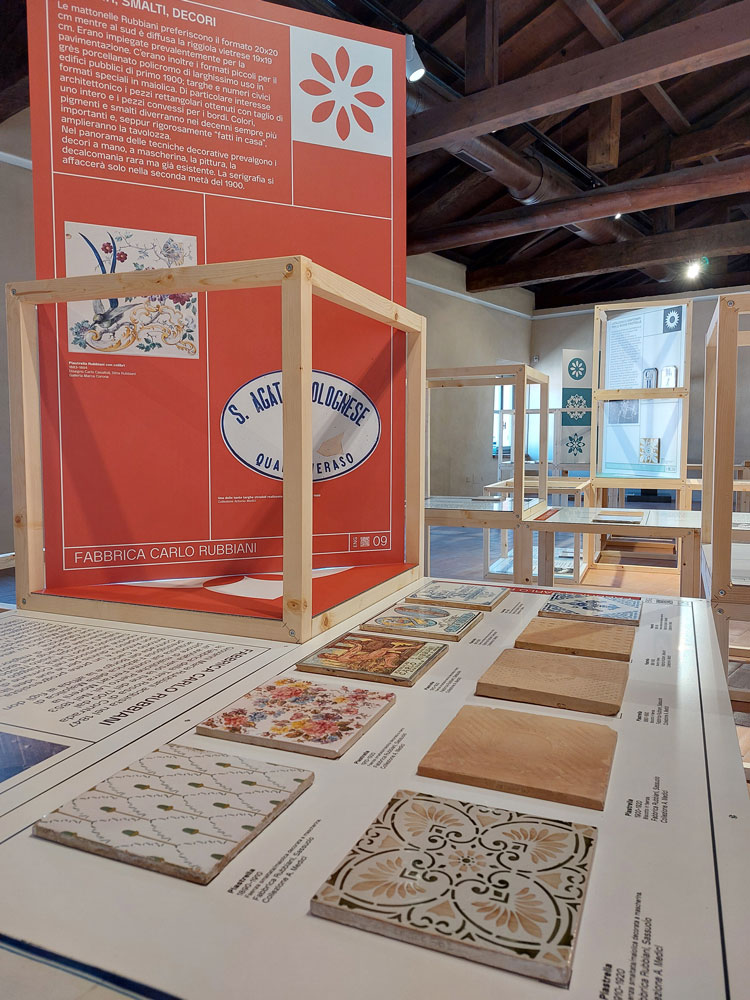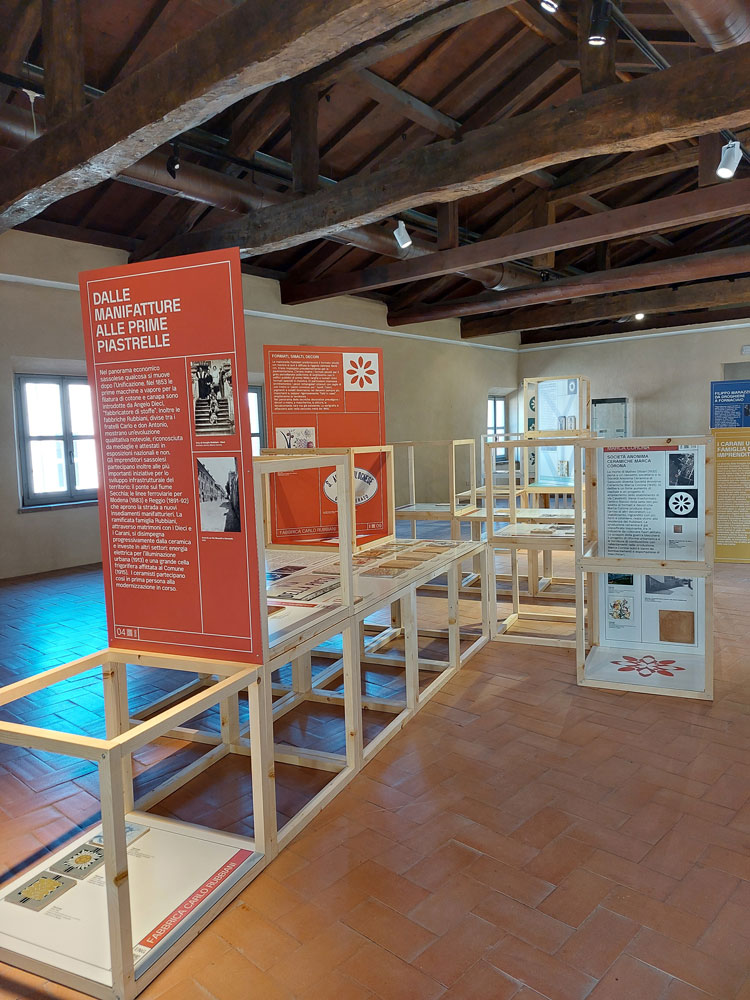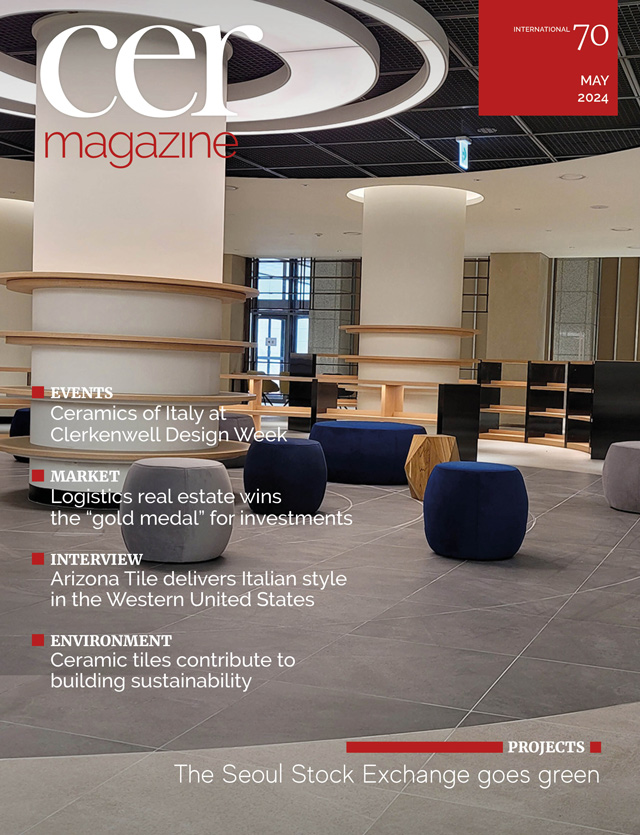An exhibition explores the origins of Italian industrial tiles
(May 2024) | “What was the year of origin of Italian ceramic tiles?”. “How did they evolve during the first few decades of their existence?”
These questions are explored in an exhibition entitled “Le piastrelle da piccole. 1889-1939, i primi cinquant’anni del Distretto” (“The early years of Italian ceramic tiles. 1889-1939: the first fifty years of the ceramic district”), currently running in the Ceramics Museum in Spezzano Castle, Municipality of Fiorano Modenese.
Very few studies have been devoted to the development of ceramic tiles in this historical period, fuelling the widespread misconception that Italian tiles did not emerge until after World War II and only rose to global prominence towards the end of the 20th century, springing up almost overnight like mushrooms.
So why can 1889 be considered the official year of birth of Italian ceramic tiles? Because that year, the exhibition held in the Museo Artistico Industriale in Rome displayed a sample of majolica tiles – dry pressed, then glazed and decorated – in place of the traditional ornamental ceramics that were then in vogue. These tiles (known at the time as “pianelle” rather than the current term “piastrelle”) had been developed by the company founded by Carlo Rubbiani using innovative presses imported from England. Recent discoveries may place this date even earlier, although further studies are required.
The company owned by Carlo Rubbiani, a scion of a well-established family of entrepreneurs, underwent several changes in ownership and management, eventually becoming Società Ceramica di Sassuolo and later Ceramiche Marca Corona.
Other ceramic tile manufacturers operating in the early decades of the 20th century were Ceramica Veggia, Stabilimento Guido Siliprandi (later known as Ceramica Saime), Saces and Marazzi. Two other smaller firms that produced tiles of rare beauty during the first few decades of the 1900s were Ing. Rizzi & Figli and Ninzoli Marconi Lusenti.
Among the larger companies, one of the most noteworthy was Ceramica Veggia, founded in 1924 on the Reggio Emilia side of the river Secchia by brickmakers Eugenio Carani and Guido Giglioli, initially under the name Carani & Giglioli. Along with a number of other innovations, engineer Antonino dal Borgo invented Kervit, a revolutionary tile with a thickness of just 3 mm produced in the early 1930s that foreshadowed today’s extra-thin porcelain tiles.
In 1926, engineer Guido Siliprandi purchased the old “Fabbrica della Terra Rossa” factory in Via Lea in the centre of Sassuolo, then in 1934 moved the operation to a modern site on the road to Modena located close to the railway, renaming it SAIME, Società Anonima Industria Materiali Edili.
In 1935, Eugenio Carani, also from a well-known family of entrepreneurs, founded the ceramic factory SACES (Società Anonima Carani Eugenio Sassuolo) on a site previously used for working timber.
The last important figure to venture into the ceramic industry was Filippo Marazzi, who after working as a grocer, in 1934 at the age of 60 set up a brickworks in the northern suburbs of Sassuolo.
In all likelihood, Marazzi decided to enter the world of ceramics because the industry had experienced continuous growth since the end of World War I, an upward trajectory only interrupted by the outbreak of World War II. After 1920, the industry received a boost from new building and public hygiene regulations requiring premises such as public slaughterhouses, dairies, cheese factories, delicatessens and butcher shops to use smooth, easily washable surfaces like ceramic tiles. Moreover, changes in domestic lifestyles pushed up demand for tiles as the most suitable and cost-effective surface covering material in kitchens, bathrooms and hallways. An additional boost to building construction and tile consumption came from the introduction of a 25-year exemption from building taxes. A 1933 report by the Modena Chamber of Commerce on the state of the provincial economy notes, “Glazed wall tile factories occupy a position of considerable importance. The industry is centred around Sassuolo, which enjoys an abundance of raw materials and a skilled workforce, trained through apprenticeships. This is one of the few industries that has never seen a slowdown in its operations.”
The industry continued to grow throughout the 1930s, both financially and in terms of equipment and output, with a steadily expanding workforce that reached almost a thousand employees. This growth was so significant that in 1940, the mayor of Sassuolo requested permission to introduce anti-urbanisation laws to curb the excessive influx of workers from neighbouring municipalities in search of employment in the ceramic industry, despite Sassuolo not reaching the requisite population of 25,000 inhabitants.
This initial boom laid the foundations for the industry’s more rapid and extensive growth during the post-World War II period, when the Modena and Reggio Emilia district established itself as the “world ceramic tile capital”.
The exhibition “Le piastrelle da piccole. 1889-1939: i primi cinquant’anni del Distretto” explores the early decades of the ceramic tile industry and takes a detailed look at company histories, entrepreneurs and technicians as well as the evolution of production processes and products. The exhibition features rare items displaying both geometric and figurative designs, some of which are of unexpected aesthetic and artistic interest and reveal early 20th-century graphic and Art Deco influences. These tiles testify to the evolution of taste and design and are now considered artistic museum pieces in their own right. The exhibition also includes images from a photographic campaign devoted to tiled surfaces that are still preserved in historic buildings in the area.
Most of the items on display originate from the collection of over 7,000 pieces assembled by Antonio Medici during his lifetime, which his family donated to the Municipality of Fiorano Modenese.
The exhibition is curated by Stefania Spaggiari, the director of the Ceramics Museum, along with a scientific committee consisting of Francesco Genitoni, Rolando Giovannini, Matteo Ruini and Vincenzo Vandelli.
It is organised by the Municipality of Fiorano Modenese in collaboration with Confindustria Ceramica, Acimac and the Italian Ceramic Society with contributions from Marca Corona for the catalogue and Marazzi Group for scientific research.
The exhibition will run until 25 May 2025 and is open on Saturdays and Sundays from 3 p.m. to 7 p.m. with free admission. Guided tours are available by appointment every day.
Info: castellospezzano@gmail.com – tel +39 335 440372.
Link: Mostre al Museo
EXHIBITION CURATORS’ BIOGRAPHIES
Francesco Genitoni has published a historical essay, short stories, novels, poems and biographies. He has also edited a number of publications on local history and literary themes. In collaboration with Stefania Spaggiari, Paola Gemelli, and Guglielmo Leoni, he curated Manodopera, a multimedia section at the Ceramics Museum of the Municipality of Fiorano Modenese located in Spezzano Castle, which was inaugurated in 2014.
Rolando Giovannini, a geologist with a diploma in decoration from the Academy of Fine Arts in Bologna, is a former lecturer at ABA Brera and SSBAP Milan Polytechnic and the fourth Principal of the Ballardini Institute in Faenza. He set up the recent tile collection at the International Museum of Ceramics (MIC) in Faenza together with Giuseppe Liverani and Gian Carlo Bojani. Curator of the scientific project for the Confindustria Ceramica Museum and the contemporary collection at the Ceramics Museum in Fiorano, he is also collaborating on the Museum of Italian Design at the Triennale in Milan (2023-2025).
Matteo Ruini is an archivist and historical researcher. After collaborating with the International Museum of Ceramics in Faenza, he is now working as a consultant at the Italian Ceramic Tile Industry Documentation Centre at Confindustria Ceramica, the Historical Gallery of Ceramiche Marca Corona s.p.a. and the Fiorano Ceramics Museum in Spezzano Castle, where he is supervising the cataloguing of the Medici collection. He is currently in the final stages of reorganising and inventorying the Carani Theatre archive and the Roberto Costi collection.
Stefania Spaggiari trained as a pre-protohistoric archaeologist but has an interest in industrial archaeology and a passion for the teaching of history. She has participated in excavation projects and published contributions on archaeology and local history. She works for the Culture and Tourism Service of the Municipality of Fiorano Modenese and is director of the Fiorano Ceramics Museum at Spezzano Castle.
Vincenzo Vandelli is an architect and a member of Studio Progettisti Associati in Sassuolo. He began his work on the Sassuolo ceramic industry in collaboration with Francesco Liverani, with whom he has published several essays. He contributed to the monograph on 250 years of ceramics in Sassuolo by Marca Corona and curated the design project for the Marca Corona Gallery. He has written about the work of Carlo Casaltoli and Terenzio Rizzoli in magazines including CER and Taccuini d’Arte.










